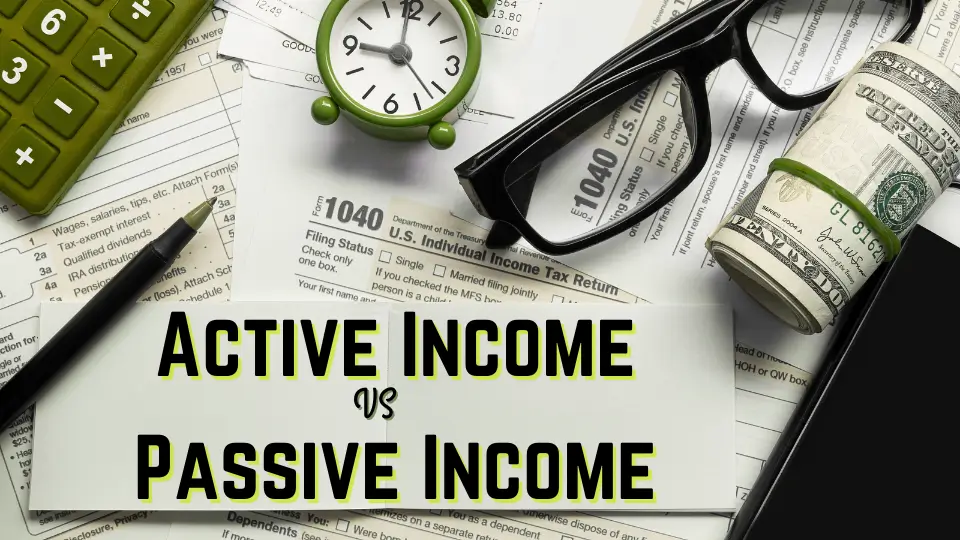Active income or Earned Income is like the MVP of your financial game. It’s the money you make by putting in your time and skills, whether you’re working a job or hustling with your own business.

Now, why is having this active income a big deal? Well, picture it as your reliable paycheck—it’s the cash flow you can count on regularly. See, active income keeps the lights on, puts food on the table, and covers those Netflix subscriptions.
It’s the backbone of your finances because it’s predictable and directly tied to your efforts. Without it, things could get a bit shaky. So, having a steady active income is crucial.
It’s like your financial safety net, helping you build a stable base while you explore other ways to grow your money, like investment income or creating passive income streams.
What is Active Income?
Active income refers to earnings generated through direct participation in a job, trade, or business where an individual is actively involved in the income-generating activities.
These types of income requires continuous effort, time, and labour to generate revenue. Examples include wages, salaries, self-employment income, and commissions.
The key characteristic of active income is the direct exchange of time and expertise for financial compensation. It’s the income earned by actively working and providing services, either as an employee or a self-employed individual.
This stands in contrast to Passive Income, where earnings are not directly tied to the number of hours worked or active involvement.
Active income is often associated with traditional employment structures where individuals receive compensation for their labour or services rendered.
Understanding the difference between active and passive income is crucial for financial planning and creating diversified income streams.
Active Income vs Passive Income

Let’s explore the comprehensive comparison between Active Income and Passive Income to grasp the fundamental distinctions between these two streams of earnings.
| Basic Elements | ACTIVE INCOME | PASSIVE INCOME |
| 1. Involvement: | Active Income requires continuous work or affort. | Passive Income doesn’t need constant hands-on involvement. |
| 2. Time Dependency: | This is directly tied to the hours you put in. | Passive Income generates earnings regardless of your active participation. |
| 3. Source: | Earned Income typically comes from salaries, wages, or services rendered. | Passive Income comes from investments, royalties, or businesses |
| 4. Predictability | It is more predictable and consistent, usually arriving in regular paychecks. | Passive Income can fluctuate but often has the potential for growth over time. |
| 5. Scalability | It has limitations based on time and effort, as you are trading your time for money. | Passive Income can be scalable, potentially growing without your direct input. |
| 6. Work vs. Ownership: | Earned Income is derived from exchanging your labour or skills. | Passive Income often involves ownership or investment in assets generating returns. |
| 7. Stability vs. Risk: | Active Income provides immediate stability but might lack long-term security. | Passive Income can entail more risk initially but offers the potential for long-term financial freedom. |
| 8. Tax Treatment: | Earned Income is usually taxed at higher rates. | Passive Income may have different tax advantages or rates. |
| 9. Diversification: | Active Income often relies on a single source. | This can be diversified across multiple streams of Income, reducing dependence on a single source. |
| 10. Lifestyle Impact: | Active Income may require continuous work, impacting lifestyle and free time. | Passive Income can offer more freedom and flexibility once established. |
READ MORE:-
👉 Understanding 3 Types of Income – Earned, Passive, and Investment
👉 Understanding Your Source of Income:- A Comprehensive Guide
Balancing Active and Passive Income: Key Benefits
Let me explain Why You Might Not Want to Have Passive Income as Your Only Source of Income. Having both active and passive income sources is like having two sturdy legs to stand on in the world of finance.

Relying solely on passive income stream might not cover all your financial needs for a few reasons:
Income Stability:
Passive income sources can fluctuate. Rental vacancies, market changes, or shifts in investment returns can impact the consistency of earnings.
It’s like your regular paycheck that you can rely on for day-to-day expenses, bills, and emergencies. This income type offers a sense of security and covers your immediate needs without having to dip into your savings or rely solely on uncertain sources.
Initial Effort and Time:
Setting up passive income streams often demands upfront effort and time. They don’t yield substantial income right away. You’ll need patience as they take time to grow and generate significant earnings.
Diversification:
Relying solely on passive income can lack diversity. Having multiple income sources (both active and passive) spreads risk and provides more stability.
If you have different ways of earning money, like a job and investments, it’s safer. If one way has problems, the others can help you stay financially stable. It’s like having a backup plan that keeps your money safer and more secure, even when things get tough.
Income Level:
At first, passive income might not be as much as a regular job. It might not cover all your expenses right away. Depending on your situation, it could be less than what you need to pay for everything.
It takes time for passive income to grow big enough to cover everything, so you might still need your regular job to take care of all your costs at the beginning.
Career Development:
Putting all your focus on passive income sources could hold back your progress in other parts of your life, like your career.
If you only concentrate on passive income, you might miss out on chances to learn new things or grow in your job.
It’s like choosing one path and not exploring other roads that could help you develop more skills or advance in your career.
Market Fluctuations:
Changes in the economy, big drops in markets, or how people buy things can affect your passive income. When the economy changes or if the market suddenly drops, the money you make from passive sources might go down.
Even how people spend their money can change and affect what you earn passively. It’s important to know that these things outside your control can impact the money you make from passive sources.
Therefore, having a mix of active (like a job or business where you’re directly involved) and passive income can offer a more stable financial foundation, allowing you to navigate uncertainties and meet various financial needs.
Conclusion
In conclusion, having an active income is like having a dependable friend in your financial journey. It’s the steady flow of cash that keeps things running smoothly, paying the bills, and supporting your everyday needs.
This kind of income is essential because it’s reliable and directly tied to the effort you put in. It’s your safety net, ensuring stability while you explore other ways to grow your money.
So, always having an active income gives you a solid foundation to build upon, making your financial life more secure and opening doors for future opportunities.
I am sure you found this post valuable. Kindly share it with those who may benefit. Stay tuned for more valuable content. Thank you for reading, and make it a fantastic day!



